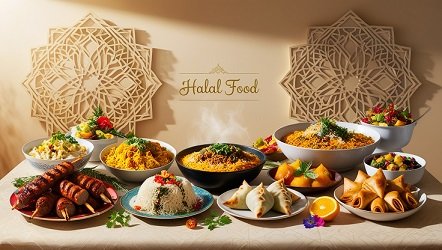Have you noticed the halal label popping up more frequently in your local grocery stores and restaurants? 🕌🍽️ You’re not alone. The halal food trend is sweeping across the globe, captivating food enthusiasts and health-conscious consumers alike. But what is halal food, and why has it suddenly become the talk of the town?
Halal, meaning “permissible” in Arabic, goes beyond just dietary restrictions. It’s a lifestyle choice that’s gaining traction for its ethical standards and perceived health benefits. From gourmet restaurants to fast-food chains, businesses are racing to cater to this growing demand. But it’s not without controversy. As the halal food market expands, so do the debates surrounding its practices and implications.
In this blog post, we’ll dive into the heart of the halal food trend, exploring its origins, its impact on the food industry, and why it’s more than just a passing fad. We’ll uncover the reasons behind its surging popularity, examine its economic footprint, and address the controversies that have arisen. Whether you’re a curious foodie or a conscious consumer, join us as we unravel the complexities of this global phenomenon and peek into the future of halal dining. 🌎🍴

Definition and Origins of Halal Food
Meaning of ‘Halal’ in Islamic context
The term ‘Halal’ is an Arabic word that translates to “permissible” or “lawful” in English. In the Islamic context, it refers to any object or action that is allowed under Islamic law. When applied to food, halal denotes items that are fit for consumption according to Islamic dietary guidelines.
Historical background of Halal dietary laws
Halal dietary laws have their roots in the Quran, the holy book of Islam, and the Hadith, which are the recorded sayings and actions of Prophet Muhammad (PBUH). These laws were established over 1400 years ago and have been followed by Muslims ever since. The primary sources of these dietary regulations are:
- Quranic verses (e.g., Al-Baqarah 2:168, Al-Ma’idah 5:3)
- Prophetic traditions
- Consensus of Islamic scholars
Importance in Muslim culture and lifestyle
Halal food plays a crucial role in Muslim culture and daily life for several reasons:
- Religious obligation
- Spiritual purification
- Health and hygiene
- Community bonding
The following table illustrates the significance of halal food in various aspects of Muslim life:
| Aspect | Importance of Halal Food |
|---|---|
| Religious | Fulfills divine commandments |
| Spiritual | Promotes mindfulness and gratitude |
| Physical | Ensures cleanliness and wholesomeness |
| Social | Strengthens community ties |
By adhering to halal dietary laws, Muslims demonstrate their commitment to their faith and maintain a sense of identity within their communities. This practice also serves as a constant reminder of their religious values and principles in everyday life.

Key Principles of Halal Food
A. Permissible and Forbidden Ingredients
Halal food adheres to strict guidelines regarding ingredients. Here’s a quick overview:
| Permissible | Forbidden |
|---|---|
| Fruits and vegetables | Pork and its by-products |
| Most seafood | Alcohol and intoxicants |
| Halal-certified meat | Blood and blood by-products |
| Milk and eggs | Carnivorous animals |
B. Halal Slaughter Methods
The Islamic method of slaughter, known as Zabiha, involves:
- Invoking the name of Allah
- Using a sharp knife to swiftly cut the animal’s throat
- Ensuring complete drainage of blood
C. Avoiding Cross-Contamination
To maintain halal status, food must be:
- Prepared with clean utensils
- Stored separately from non-halal items
- Cooked in dedicated halal-only areas
D. Ethical Considerations in Food Production
Halal principles extend beyond ingredients to encompass ethical practices:
- Humane treatment of animals
- Sustainable farming methods
- Fair labor practices
These key principles ensure that halal food not only meets religious requirements but also upholds high standards of ethics and food safety. Understanding these principles is crucial for both producers and consumers in the halal food market. As we delve deeper into the subject, we’ll explore specific examples of halal and non-halal foods in the next section.

Common Halal and Non-Halal Foods
A. Meat and poultry guidelines
Halal meat and poultry must come from permissible animals slaughtered according to Islamic law. Here’s a quick reference:
| Halal | Non-Halal |
|---|---|
| Chicken | Pork |
| Beef | Horse meat |
| Lamb | Carnivorous animals |
| Goat | Birds of prey |
The animal must be healthy and slaughtered by a Muslim who recites a prayer during the process.
B. Seafood regulations
Generally, most seafood is considered halal. This includes:
- Fish with scales
- Shrimp
- Lobster
- Crab
Some scholars debate the permissibility of shellfish, but it’s widely accepted in many Muslim communities.
C. Vegetarian and vegan options
Vegetarian and vegan foods are typically halal, provided they don’t contain any prohibited additives. Popular options include:
- Fruits and vegetables
- Grains and legumes
- Plant-based proteins (tofu, tempeh)
- Nuts and seeds
D. Prohibited substances and additives
Several substances are strictly forbidden in halal food:
- Alcohol and intoxicants
- Animal-derived gelatin (unless from halal sources)
- Enzymes from non-halal animal sources
- Carmine (red food coloring from insects)
Food manufacturers must ensure these substances are not present in halal-certified products.
Halal Certification Process
Now that we understand the key principles of halal food, let’s explore the certification process that ensures these standards are met.
Role of Certifying Bodies
Halal certifying bodies play a crucial role in maintaining the integrity of halal food products. These organizations:
- Conduct thorough inspections of food production facilities
- Verify ingredients and production methods
- Issue halal certificates to compliant companies
- Perform regular audits to ensure ongoing compliance
Steps to Obtain Halal Certification
The process of obtaining halal certification typically involves the following steps:
- Application submission
- Document review
- On-site inspection
- Laboratory testing (if necessary)
- Evaluation of findings
- Certification decision
| Step | Description |
|---|---|
| Application | Company submits required documents |
| Inspection | Experts assess production processes |
| Testing | Products analyzed for prohibited substances |
| Decision | Certification granted if all criteria are met |
Global Standards and Variations
While the basic principles of halal certification are universal, there can be variations in standards and practices across different countries and certifying bodies. Some key differences include:
- Acceptable stunning methods for animal slaughter
- Use of certain food additives and processing aids
- Requirements for halal storage and transportation
These variations highlight the importance of choosing a reputable certifying body that aligns with the target market’s expectations and regulations.
Next, we’ll examine the growing halal food industry and its market potential.
Halal Food Industry and Market
The Halal food industry has experienced remarkable growth in recent years, driven by increasing Muslim populations and growing awareness among non-Muslim consumers. Let’s explore the various aspects of this thriving market.
Growth of Halal Food Sector
The Halal food sector has seen exponential growth globally:
- Annual growth rate: 5-7%
- Estimated market size: $2.5 trillion by 2024
- Key markets: Southeast Asia, Middle East, Western countries
Challenges in Halal Food Production
Despite its growth, the industry faces several challenges:
- Standardization of certification processes
- Supply chain complexities
- Limited availability of Halal ingredients
- Lack of skilled workforce in Halal food production
Opportunities for Businesses
The expanding Halal market presents numerous opportunities:
| Opportunity | Description |
|---|---|
| Product Innovation | Developing new Halal-certified products |
| Market Expansion | Entering untapped markets with high Muslim populations |
| Digital Marketing | Leveraging online platforms to reach Halal-conscious consumers |
| Halal Tourism | Catering to Muslim travelers with Halal food options |
Consumer Demand and Preferences
Understanding consumer preferences is crucial for success in the Halal food market:
- Increasing demand for convenience foods
- Growing interest in organic and healthy Halal options
- Rise of Halal-certified gourmet and specialty products
- Preference for transparent and traceable Halal supply chains
As the Halal food industry continues to evolve, businesses that adapt to these trends and overcome challenges will be well-positioned to capitalize on this growing market. Next, we’ll address some common misconceptions about Halal food to provide a clearer understanding of this dietary practice.
Misconceptions about Halal Food
Health and Safety Concerns
Many people mistakenly believe that halal food is less safe or hygienic than non-halal food. In reality, halal food production often adheres to strict cleanliness and quality standards. The meticulous slaughtering process and emphasis on animal health contribute to food safety.
Animal Welfare Debates
A common misconception is that halal slaughter is cruel to animals. However, Islamic law requires minimizing animal suffering. The swift and precise method used in halal slaughter is designed to be as humane as possible.
Cultural Stereotypes
Halal food is sometimes associated with specific cultures or ethnicities, leading to stereotypes. In fact, halal food is consumed by people from diverse backgrounds and is not limited to any particular culture.
Comparison with Other Dietary Restrictions
Many people confuse halal with other dietary restrictions. Here’s a comparison:
| Dietary Restriction | Main Characteristics |
|---|---|
| Halal | Permissible in Islamic law, focus on meat preparation |
| Kosher | Jewish dietary laws, similar to halal but with additional rules |
| Vegetarian | Excludes meat and fish |
| Vegan | Excludes all animal products |
Understanding these differences helps dispel misconceptions about halal food and its place among other dietary practices.
Now that we’ve addressed common misconceptions, it’s clear that halal food is rooted in principles of cleanliness, ethics, and respect for life, rather than the myths often associated with it.
Conclusion
The Halal food trend has emerged as a significant force in the global culinary landscape, offering a unique blend of tradition, health benefits, and diverse flavors. From understanding the basics of Halal food to exploring popular cuisines and navigating the certification process, this growing market presents both opportunities and challenges for consumers and businesses alike.
As the Halal food industry continues to evolve, it’s clear that its influence extends far beyond religious observance. Whether you’re seeking healthier eating options, exploring new culinary experiences, or simply curious about this rising trend, the world of Halal food offers something for everyone. Embrace the opportunity to discover the rich flavors and cultural significance of Halal cuisine, and be part of a movement that’s reshaping the global food landscape.
